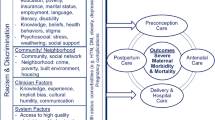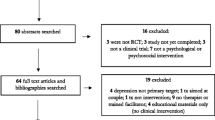Abstract
Prenatal psychosocial health has been linked with health behaviors, maternal health, and birth outcomes. This randomized controlled trial evaluated the effects of a prenatal depression intervention on birth outcomes and maternal physical and psychological status at 42 days postpartum. Three hundred fifty-two high-risk pregnant women exposed to obstetric complications with an Edinburgh Postnatal Depression Scale (EPDS) ≥ 9 or a Postpartum Depression Screening Scale (PDSS) ≥ 60 were randomly assigned to the intervention group (n = 176) and control group (n = 176). The intervention group underwent a six-session couple-separated psycho-educational program; the control group received the usual care. All participants were asked to complete questionnaires at late pregnancy (>28 weeks), 3 days postpartum, and 42 days postpartum. The intervention group had a significantly lower cesarean rate and shorter third stage of labor (p < .05). At 42 days after delivery, only 5.1% of participants were lost to follow-up, and the intervention group had significantly less minor and major depression, more sleep time, more satisfaction with their husband and other family members, less concern about taking care of baby, and less breast milk insufficiency than the control group (p < .05). A prenatal psychological intervention model for high-risk pregnant women holds potential as a preventive program that addresses maternal health and birth outcomes.
Trial registration: Chinese Clinical Trial Registry (ChiCTR-IOR-15006433), http://www.chictr.org.cn/enIndex.aspx (retrospectively registered).

Similar content being viewed by others
References
Anderson CA, Lieser C (2015) Prenatal depression: early intervention. Nurse Pract 40(7):38–46
Andersson L, Sundström-Poromaa I, Bixo M, Wulff M, Bondestam K, åStröm M (2003) Point prevalence of psychiatric disorders during the second trimester of pregnancy: a population-based study. Am J Obstet Gynecol 189:148–154
Bayrampour H, Salmon C, Vinturache A, Tough S (2015) Effect of depressive and anxiety symptoms during pregnancy on risk of obstetric interventions. J Obstet Gynaecol Res 41(7):1040–1048
Beck CT, Gable RK (2001) Comparative analysis of the performance of the Postpartum Depression Screening Scale with two other depression instruments. Nurs Res 50(4):242–250
Benute GR, Nomura RM, Reis JS, Fraguas Junior R, Lucia MC, Zugaib M (2010) Depression during pregnancy in women with a medical disorder: risk factors and perinatal outcomes. Clinics 65(11):1127–1131
Chan J, Natekar A, Einarson A, Koren G (2014) Risks of untreated depression in pregnancy. Can Fam Physician 60(3):242–243
Claridge AM (2014) Efficacy of systemically oriented psychotherapies in the treatment of perinatal depression: a meta-analysis. Arch Womens Ment Health. 17(1):3–15
Cox JL, Holden JM, Sagovsky R (1987) Detection of postnatal depression. Development of the 10-item Edinburgh postnatal depression scale. Br J Psychiatry 150:782–786
Dai ZE (2014) Impact analysis of nursing intervention on bad mood of the high-risk pregnant woman. Guide of China Medicine 12:375–376
Dayan J, Creveuil C, Marks MN, Conroy S, Herlicoviez M, Dreyfus M, Tordjman S (2006) Prenatal depression, prenatal anxiety, and spontaneous preterm birth: a prospective cohort study among women with early and regular care. Psychosom Med 68:938–946
Dhobale MV, Pisal HR, Mehendale SS, Joshi SR (2013) Differential expression of human placental neurotrophic factors in preterm and term deliveries. Int J Dev Neurosci 31(8):719–723
Feinberg ME, Roettger ME, Jones DE, Paul IM, Kan ML (2015) Effects of a psychosocial couple-based prevention program on adverse birth outcomes. Matern Child Health J 19(1):102–111
Field T, Diego M, Hernandez-Reif M, Figueiredo B, Deeds O, Ascencio A, Schanberg S, Kuhn C (2010) Comorbid depression and anxiety effects on pregnancy and neonatal outcome. Infant Behav Dev 33(1):23–29
Gibson J, McKenzie-McHarg K, Shakespeare J, Price J, Gray R (2009) A systematic review of studies validating the Edinburgh Postnatal Depression Scale in antepartum and postpartum women. Acta Psychiatr Scand 119:350–364
Grigoriadis S, VonderPorten EH, Mamisashvili L, Tomlinson G, Dennis CL, Koren G, Steiner M, Mousmanis P, Cheung A, Radford K, Martinovic J, Ross LE (2013) The impact of maternal depression during pregnancy on perinatal outcomes: a systematic review and meta-analysis. J Clin Psychiatry 74(4):e321–e341
Hamdan A, Tamim H (2011) Psychosocial risk and protective factors for postpartum depression in the United Arab Emirates. Arch Womens Ment Health. 14(2):125–133
Han XS (2013) Study of antenatal care requirement and nursing among high-risk pregnant women. Contemporary Medicine 19(19):115–117
Hübner-Liebermann B, Hausner H, Wittmann M (2012) Recognizing and treating peripartum depression. Dtsch Arztebl Int 109(24):419–424
Kaihola H, Olivier J, Poromaa IS, Åkerud H (2015) The effect of antenatal depression and selective serotonin reuptake inhibitor treatment on nerve growth factor signaling in human placenta. PLoS One 10(1):e0116459
Katon WJ, Russo JE, Melville JL, Katon JG, Gavin AR (2012) Depression in pregnancy is associated with preexisting but not pregnancy-induced hypertension. Gen Hosp Psychiatry 34:9–16
Kingston D, Janes-Kelley S, Tyrrell J, Clark L, Hamza D, Holmes P, Parkes C, Moyo N, McDonald S, Austin MP (2015) An integrated web-based mental health intervention of assessment-referral-care to reduce stress, anxiety, anddepression in hospitalized pregnant women with medically high-risk pregnancies: a feasibility study protocol of hospital-based implementation. JMIR Res Protoc 4(1):e9
Kozinszky Z, Dudas RB, Devosa I, Csatordai S, Tóth E, Szabó D, Sikovanyecz J, Barabás K, Pál A (2012) Can a brief antepartum preventive group intervention help reduce postpartum depressive symptomatology. Psychother Psychosom 81(2):98–107
Lau Y, Yin L, Wang Y (2011) Antenatal depressive symptomatology, family conflict and social support among Chengdu Chinese women. Matern Child Health J 15(8):1416–1426
Lee DT, Yip SK, Chiu HF, Leung TY, Chan KP, Chau IO, Leung HC, Chung TK (1998) Postnatal depression in Chinese women. Br J Psychiatry 172(5):433–437
Leung SS, Lam TH (2012) Group antenatal intervention to reduce perinatal stress and depressive symptoms related to intergenerational conflicts: a randomized controlled trial. Int J Nurs Stud 49(11):1391–1402
Li D, Liu L, Odouli R (2009) Presence of depressive symptoms during early pregnancy and the risk of preterm delivery: a prospective cohort study. Hum Reprod 24:146–153
Li LZ, Liu F, Zhang HL, Wang L, Chen X (2011) Chinese version of the Postpartum Depression Screening Scale translation and validation. Nurs Res 60(4):231–239
Liou SR, Wang P, Cheng CY (2016) Effects of prenatal maternal mental distress on birth outcomes. Women Birth 29(4):376–380
Lukkari S, Hakko H, Herva A, Pouta A, Riala K, Räsänen P (2012) Exposure to obstetric complications in relation to subsequent psychiatric disorders of adolescent inpatients: specific focus on gender differences. Psychopathology 45(5):317–326
Ma H, Zhang Y, Wang XD, Bai YL (2012) Effect of psychological and behavioral intervention on pregnancy outcome and negative mood for high-risk pregnant women. Chinese Journal of Behavior Medicine & Brain Science 21(9):813–816
Maxson PJ, Edwards SE, Valentiner EM, Miranda ML (2016) A multidimensional approach to characterizing psychosocial health during pregnancy. Matern Child Health J 20(6):1103–1113
Mendelson T, Leis JA, Perry DF, Stuart EA, Tandon SD (2013) Impact of a preventive intervention for perinatal depression on mood regulation, social support, and coping. Arch Womens Ment Health 16(3):211–218
Myors KA, Schmied V, Johnson M, Cleary M (2014) Therapeutic interventions in perinatal and infant mental health services: a mixed methods inquiry. Issues Ment Health Nurs 35(3):372–385
Neggers Y, Goldenberg R, Cliver S, Hauth J (2006) The relationship between psychosocial profile, health practices, and pregnancy outcomes. Acta Obstet Gynecol Scand 85(3):277–285
Nishioka E, Haruna M, Ota E, Matsuzaki M, Murayama R, Yoshimura K, Murashima S (2011) A prospective study of the relationship between breastfeeding and postpartum depressive symptoms appearing at 1-5 months after delivery. J Affect Disord 133(3):553–559
Pesonen AK, Lahti M, Kuusinen T, Tuovinen S, Villa P, Hämäläinen E, Laivuori H, Kajantie E, Räikkönen K (2016) Maternal prenatal positive affect, depressive and anxiety symptoms and birth outcomes: the PREDO study. PLoS One 11(2):1–13
Saeed A, Raana T, Saeed AM, Humayun A (2016) Effect of antenatal depression on maternal dietary intake and neonatal outcome: a prospective cohort. Nutr J 15(1):64
Shanghai High-risk Pregnancy Grading (nd) Maternal health care work specification compilation. http://wenku.baidu.com/view/4fb1d0d380eb6294dd886ca6.html
Sheehan DV, Lecrubier Y, Sheehan KH, Amorim P, Janavs J, Weiller E, Hergueta T, Baker R, Dunbar GC (1998) The development and validation of a structured diagnostic psychiatric interview for DSM-IV and ICD-10. 59:22–57
Signal TL, Paine SJ, Sweeney B, Muller D, Priston M, Lee K, Gander P, Huthwaite M (2016) The prevalence of symptoms of depression and anxiety, and the level of life stress and worry in New Zealand Māori and non-Māori women in late pregnancy. Aust N Z J Psychiatry. doi:10.1177/0004867415622406
Siu BW, Leung SS, Ip P, Hung SF, O’Hara MW (2012) Antenatal risk factors for postnatal depression: a prospective study of chinese women at maternal and child health centres. BMC Psychiatry 12:22
Sun XJ (2012) Investigation and analysis on antenatal psychological status of high-risk pregnant women. Journal of QiLu Nursing 18(23):42–43
Tachibana Y, Koizumi T, Takehara K, Kakee N, Tsujii H, Mori R, Inoue E, Ota E, Yoshida K, Kasai K, Okuyama M, Kubo T (2015) Antenatal risk factors of postpartum depression at 20 weeks gestation in a Japanese sample: psychosocial perspectives from a cohort study in Tokyo. PLoS One 10(12):e0142410
Tan XY, Guo WH, Wang AM (2011) Analysis of psychological state and influencing factors of high risk pregnancies before cesarean section. Journal of Nursing 18:74–76
Toohill J, Fenwick J, Gamble J, Creedy DK, Buist A, Turkstra E, Ryding EL (2014) A randomized controlled trial of a psycho-education intervention by midwives in reducing childbirth fear in pregnant women. Birth 41(4):384–394
Zeng SQ (2010) Risk assessment and holistic nursing on high-risk pregnant women during prenatal period. Nursing Practice and Study 7(10):52–54
Zhao Y, Kane I, Wang J, Shen B, Luo J, Shi S (2015) Combined use of the Postpartum Depression Screening Scale (PDSS) and Edinburgh Postnatal Depression Scale (EPDS) to identify antenatal depression among Chinese pregnant women with obstetric complications. Psychiatry Res 226:113–119
Zhao Y, Kane I, Mao L, Shi S, Wang J, Lin Q, Luo J (2016) The prevalence of antenatal depression and its related factors in Chinese pregnant women who present with obstetrical complications. Arch Psychiatr Nurs 30(3):316–321
Acknowledgements
This work was supported by the China Medical Board (CMB) (No. 10-020-201206). We gratefully acknowledge the important contributions of our consultants: Cai Yiyun and Chen Jing. We also thank our research staff: Ding Yan and Tao Hua as well as all high-risk pregnant women who participated in the present study. There are no personal, organizational, or financial conflicts of interest.
Author information
Authors and Affiliations
Corresponding authors
Ethics declarations
This randomized single-blind controlled trial was conducted from November 1, 2014 to August 31, 2015. It was approved by the ethical committee of the Fudan University affiliated Obstetrics and Gynecology Hospital in 2013 and 2015 (24-C-2015-24, [2013]24) and registered in the Chinese Clinical Trial Registry (ChiCTR-IOR-15006433). After providing their written informed consents, the participants were randomly assigned into the intervention and control groups and asked to complete questionnaires on depressive symptomatology and psychosocial correlates.
Additional information
Michelle L. Munro-Kramer and Jianfeng Luo are co-authors.
Rights and permissions
About this article
Cite this article
Zhao, Y., Munro-Kramer, M.L., Shi, S. et al. A randomized controlled trial: effects of a prenatal depression intervention on perinatal outcomes among Chinese high-risk pregnant women with medically defined complications. Arch Womens Ment Health 20, 333–344 (2017). https://doi.org/10.1007/s00737-016-0712-7
Received:
Accepted:
Published:
Issue Date:
DOI: https://doi.org/10.1007/s00737-016-0712-7




